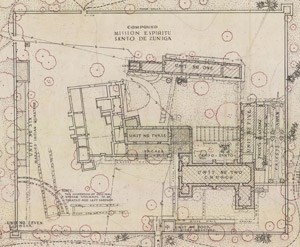
Mission Nuestra Señora de la Bahía del Espíritu Santo de Zúñiga
Goliad State Park and Historic Site
Goliad, Texas
Coordinates: 28.655422,-97.388459
#TravelSpanishMissions
Discover Our Shared Heritage
Spanish Colonial Missions of the Southwest Travel Itinerary

Photo by Ernest Mettendorf. Courtesy of Wikimedia Commons.

Drawn by T. Phinney and S. Vosper for the National Park Service. Courtesy of Texas State Archives.


Plan Your Visit
Mission of Nuestra Señora del Espíritu Santo de Zuñiga is part of Goliad State Park and Historic Site, and is listed in the National Register of Historic Places. The state park is located at 108 Park Rd. 6, Goliad, TX. To get to the park, travel .25 mile south of Goliad on U.S. Highway 183 and 77A. The park is open daily from 8:00am to 5:00pm year round except for Christmas Day. There is a small entrance fee. For more information visit the Goliad State Park and Historic Site website or call 361-645-3405.
Nearby, is the Presidio Nuestra Señora de Loreto de Bahía, which is a National Historic Landmark and featured in the National Park Service American Latino Heritage Travel Itinerary and the National Park Service South and West Texas Travel Itinerary.
Last updated: April 15, 2016
